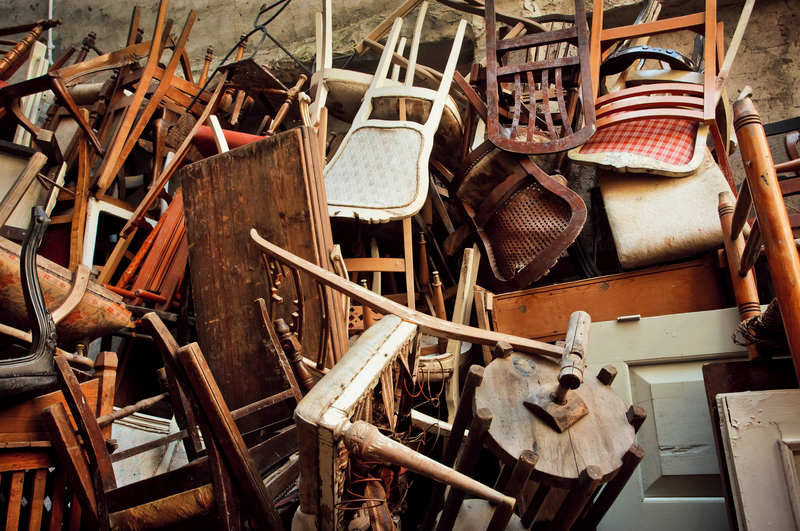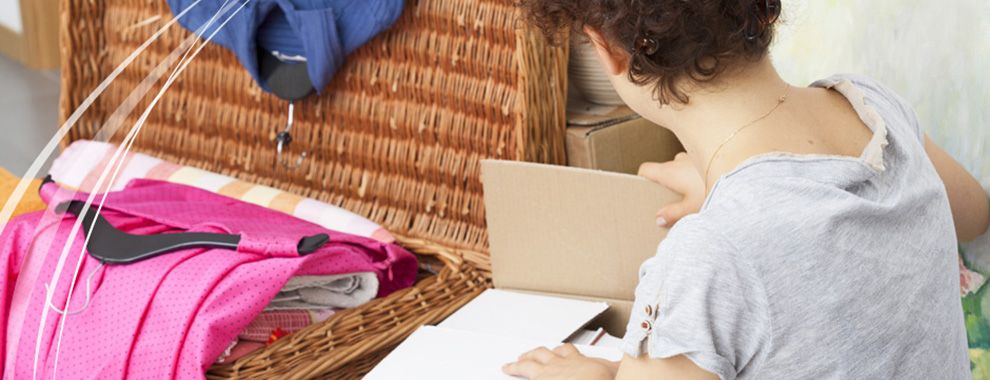Preserve Your Sofa with These Long-Term Storage Techniques
Posted on 17/05/2025
Preserve Your Sofa with These Long-Term Storage Techniques
Is your living space getting crowded or are you heading out on a long trip? Maybe you're moving into a smaller home, preparing for renovations, or simply want to protect your beloved couch until it's ready for a second life. Whatever the reason, knowing how to preserve your sofa with expert long-term storage techniques ensures it stays in excellent shape and ready to use when the time is right.
In this comprehensive guide, we'll walk you through everything you need to know about sofa storage solutions. We'll cover preparation, packing, and storage environment tips to help you maintain your couch's appearance, structure, and longevity.

Why Proper Sofa Storage Matters
Sofas are more than just functional furniture--they're an investment and, for many, hold sentimental value. Unfortunately, improper storage can result in irreparable damage, including mold, mildew, fabric fading, pest infestation, or structural warping. With the right long-term furniture storage techniques, you can prevent these problems and extend the life of your couch.
- Prevents pest and rodent damage that can ruin upholstery and frame.
- Protects against moisture and mold growth that can cause health concerns.
- Maintains sofa aesthetics by avoiding dust and sunlight fading.
- Preserves comfort and structural integrity for future use.
How to Prepare Your Sofa for Long-Term Storage
1. Thorough Cleaning and Conditioning
Before you even consider storing your couch, proper cleaning and conditioning is crucial to prevent lingering odors, mold, and permanent stains.
- Vacuum every surface -- Use a soft brush and crevice attachment to reach under cushions and in seams.
- Spot clean stains using manufacturer-recommended cleaning products for fabric or leather.
- For leather sofas, use a dedicated conditioner to prevent drying and cracking.
- Let the sofa air dry completely before wrapping or moving it.
Tip: If possible, steam clean fabric sofas before storage to kill any dust mites or bacteria.
2. Disassemble When Possible
Disassembling your sofa can make storage and transportation much easier and safer for both the couch and your back.
- Remove legs, cushions, and any detachable parts.
- Keep screws and hardware in a labeled bag, attached securely to the main frame.
- Store removable parts in breathable fabric bags to allow air circulation.
Never force parts apart. Consult the sofa manual or manufacturer for guidance on safe disassembly to avoid damage.
3. Protect Surfaces with Proper Materials
Avoid the temptation to use cheap plastic wraps, which can trap moisture and encourage mold. Instead, opt for these sofa protection materials:
- Breathable furniture covers or moving blankets (these allow airflow and prevent dust accumulation).
- Old sheets or cotton drop cloths (great for gentle surface protection).
- For added protection, tuck silica gel packs or moisture absorbers inside and underneath the sofa.
Securing your covers with twine or straps (rather than tape) will help prevent adhesive residue on the fabric.
Choosing the Ideal Environment for Sofa Storage
1. Climate-Controlled Storage Is a Must
If you're aiming to store your sofa long-term, investing in a climate-controlled unit is the best way to ensure the couch's longevity.
- Maintain a temperature between 55-75?F to prevent warping, mold, and fabric damage.
- Keep humidity levels below 55% to avoid moisture-related issues.
- Do not store sofas in damp basements, attics, or garages where temperature and moisture fluctuate.
Pro Tip: If you must use a non-climate-controlled area, regularly check and replace moisture absorbers, and position the sofa on pallets to avoid ground moisture.
2. Mindful Storage Positioning and Placement
How you place your sofa in storage makes a big difference:
- Never stack heavy boxes or items on the sofa -- this can lead to permanent indentations or structural damage.
- Keep your couch elevated on wooden pallets or risers to protect against any floor dampness.
- Leave space (at least a few inches) around all sides for air circulation and easy inspection.
- Keep away from direct sunlight inside the unit to prevent fabric fading or leather drying.
3. Pest and Odor Prevention
Pests and odors are the enemies of long-term sofa storage. Take these steps to fend them off:
- Inspect storage areas for signs of insects or rodents before moving your furniture in.
- Use natural pest deterrents, such as cedar blocks or lavender sachets.
- Place baking soda packets nearby to neutralize any lingering odors.
- Regularly visit or ask someone to check the storage unit to catch pest issues early.
The Step-by-Step Guide to Storing Your Sofa
Step 1: Double-Check Cleanliness
Make sure your sofa is completely dry after cleaning to avoid mildew. A clean, dry sofa is the best defense against unwanted smells and stains setting in during storage.
Step 2: Wrap and Protect
- Wrap each sofa part individually (arms, cushions, frame) in protective covers or fabric sheets.
- Avoid sealing the covers too tightly; you want the sofa to "breathe" and avoid trapped humidity.
Step 3: Move with Care
- Use dollies or sliders to move the sofa, minimizing pressure on legs and joints.
- Lifting rather than dragging prevents accidental tears or snaps.
Step 4: Position Correctly in the Storage Unit
- Elevate your sofa on pallets and keep it upright.
- Face cushions inwards or cover them well if facing out to minimize accidental scuffs.
- Allow for air flow all around the sofa by leaving a small gap from walls and other items.
Step 5: Ongoing Maintenance
- Visit the storage site every few months to air out covers, check for moisture, and inspect for pests.
- Replace desiccant packs and odor absorbers as needed.
Best Storage Materials for Sofa Preservation
Selecting the right materials for couch preservation will ensure your sofa is protected from more than just dust. Here's what you'll need:
- Heavy-duty moving blankets -- offer thick, cushioned protection against knocks and temperature shifts.
- Breathable fabric covers -- cotton or linen sheets are excellent for airflow.
- Plastic wrap (only for short-term moves, not long-term, as it can trap moisture).
- Furniture pads -- for covering sharp edges and corners.
- Wooden pallets or furniture risers -- vital for keeping the couch off the ground.
- Zip ties, twine, or straps for securing covers safely.
Common Mistakes to Avoid with Sofa Storage
- Skipping the cleaning process: Dust and crumbs can attract pests and lead to stains.
- Wrapping too tightly in plastic: Traps moisture and encourages mold.
- Storing your sofa against walls or other furniture: Prevents airflow and can lead to mildew.
- Storing on ground level in damp areas: Increases the risk of water damage.
- Neglecting regular check-ins: Small issues can become major if not detected early.
- Stacking items on your couch: Causes permanent dents, tears, and frame warping.
Extra Tips for Storing Specific Sofa Types
Storing a Leather Sofa
- Clean with leather-safe products before storage.
- Condition the surface to retain moisture and prevent cracking.
- Keep in low-humidity, temperature-controlled units.
- Avoid plastic covers at all costs!
Storing Upholstered/Fabric Sofas
- Steam clean and air dry completely.
- Use breathable covers to prevent mold and musty smells.
- Place silica gel packets in crevices for extra moisture control.
Storing Modular or Sectional Sofas
- Disassemble pieces for safer handling and storage.
- Label parts so you can easily reassemble later.

When to Retrieve or Rotate Your Sofa in Storage
Even if your sofa is stored for a long stretch, regular visits can help prolong its life:
- Open covers and inspect for mold, pests, and odors every six months.
- Reposition the sofa slightly to avoid pressure points developing.
- If storing for over a year, give it a good airing and clean before using again.
Conclusion: Keep Your Sofa Safe for the Long Haul
Your sofa is a central part of your home's comfort and style. Using these expert long-term sofa storage solutions will help you avoid common pitfalls and ensure your furniture remains in like-new condition for years ahead. Proper cleaning, breathable protection, a careful storage environment, and regular check-ins are the cornerstones of effective sofa preservation.
Don't let your investment deteriorate in storage -- follow these proven techniques and your couch will be ready to be the star of your living room once again.
Frequently Asked Questions on Sofa Storage
- How long can I store a sofa without damage?
With proper preparation and a climate-controlled unit, you can store a sofa for several years. - What's the best way to move a sofa into storage?
Disassemble what you can, wrap each part individually, and use moving tools to protect both the couch and your floors. - Can I use regular plastic wrap for long-term storage?
It's better to use breathable covers as plastic can trap moisture and cause mold over long periods.
For more furniture care guides and expert tips, explore our site or connect with professional moving and storage services near you. Preserve your sofa now to enjoy it for years to come!









